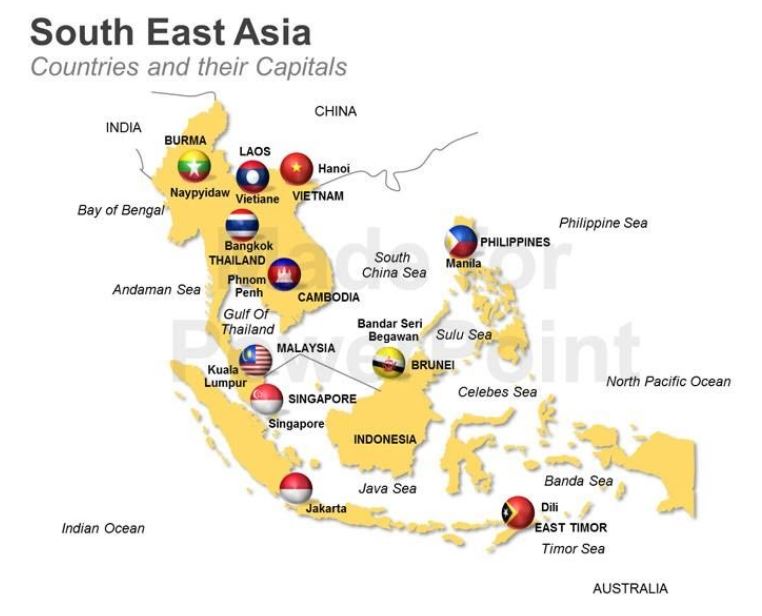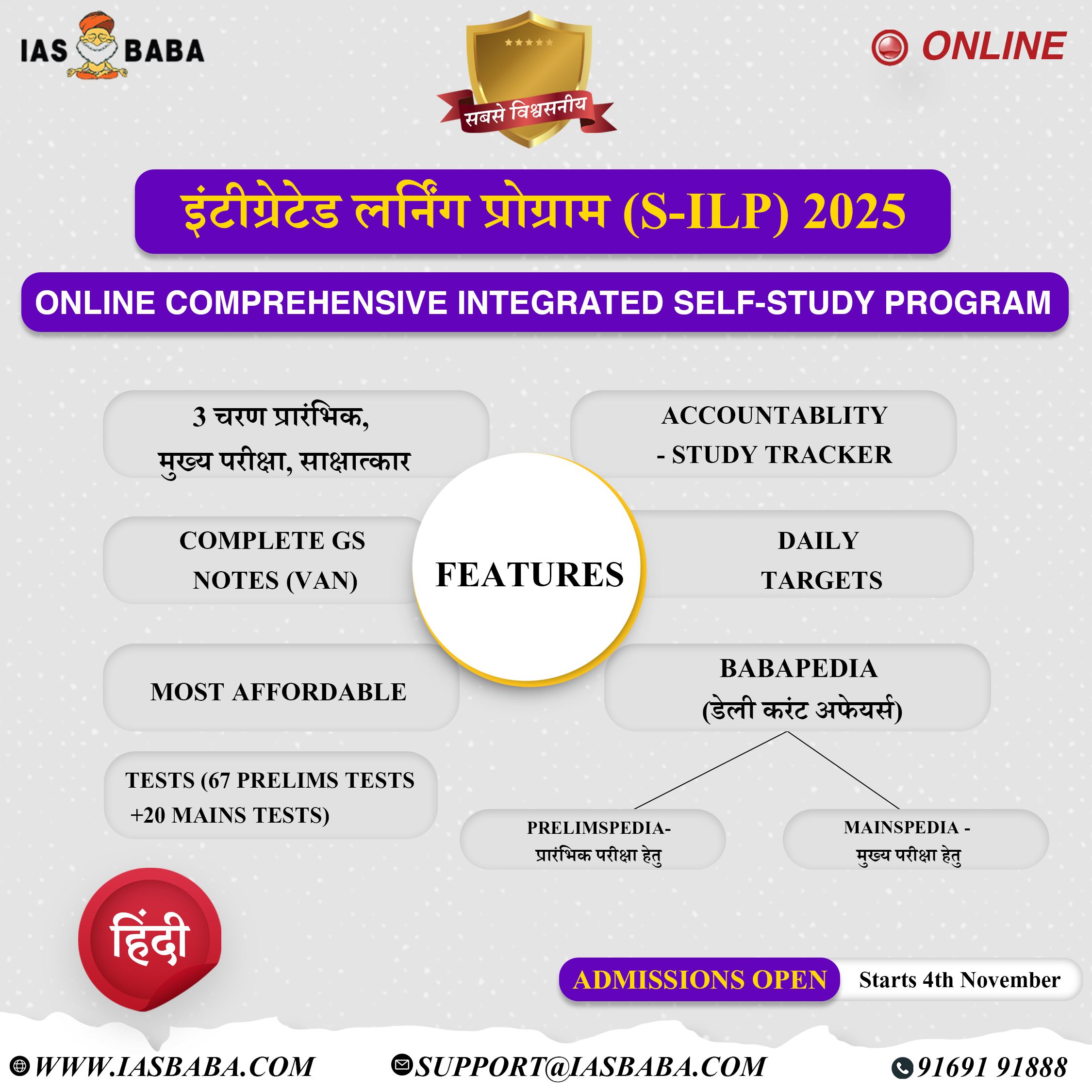IASbaba Daily Prelims Quiz
For Previous Daily Quiz (ARCHIVES) – CLICK HERE
The Current Affairs questions are based on sources like ‘The Hindu’, ‘Indian Express’ and ‘PIB’, which are very important sources for UPSC Prelims Exam. The questions are focused on both the concepts and facts. The topics covered here are generally different from what is being covered under ‘Daily Current Affairs/Daily News Analysis (DNA) and Daily Static Quiz’ to avoid duplication. The questions would be published from Monday to Saturday before 2 PM. One should not spend more than 10 minutes on this initiative.
This is a part of our recently launched, NEW INITIATIVE IASbaba’s INTEGRATED REVISION PLAN (IRP) 2020 – Road Map for the next 100 Days! FREE INITIATIVE!
We will make sure, in the next 4 months not a single day is wasted. All your energies are channelized in the right direction. Trust us! This will make a huge difference in your results this time, provided that you follow this plan sincerely every day without fail.
Gear up and Make the Best Use of this initiative.
Do remember that, “the difference between Ordinary and EXTRA-Ordinary is PRACTICE!!”
To Know More about the Initiative -> CLICK HERE
SCHEDULE/DETAILED PLAN – > CLICK HERE
Important Note:
- Don’t forget to post your marks in the comment section. Also, let us know if you enjoyed today’s test 🙂
- After completing the 5 questions, click on ‘View Questions’ to check your score, time taken and solutions.
Test-summary
0 of 5 questions completed
Questions:
- 1
- 2
- 3
- 4
- 5
Information
To view Solutions, follow these instructions:
- Click on – ‘Start Test’ button
- Solve Questions
- Click on ‘Test Summary’ button
- Click on ‘Finish Test’ button
- Now click on ‘View Questions’ button – here you will see solutions and links.
You have already completed the test before. Hence you can not start it again.
Test is loading...
You must sign in or sign up to start the test.
You have to finish following test, to start this test:
Results
0 of 5 questions answered correctly
Your time:
Time has elapsed
You have scored 0 points out of 0 points, (0)
| Average score |
|
| Your score |
|
Categories
- Not categorized 0%
| Pos. | Name | Entered on | Points | Result |
|---|---|---|---|---|
| Table is loading | ||||
| No data available | ||||
- 1
- 2
- 3
- 4
- 5
- Answered
- Review
-
Question 1 of 5
1. Question
Consider the following pairs
Term Explanation
- Undernourishment Population with insufficient caloric intake.
- Child Wasting Children under age eight who have low weight for their height,
- Child Stunting Children under age five who have low height for their age
- Child Mortality The mortality rate of children under the age of eight
Which of the above pairs is/are correct?
Correct
Solution (c)
- Undernourishment: Share of the population with insufficient caloric intake.
- Child Wasting: Share of children under age five who have low weight for their height, reflecting acute undernutrition.
- Child Stunting: Share of children under age five who have low height for their age, reflecting chronic undernutrition.
- Child Mortality: The mortality rate of children under the age of five.
Incorrect
Solution (c)
- Undernourishment: Share of the population with insufficient caloric intake.
- Child Wasting: Share of children under age five who have low weight for their height, reflecting acute undernutrition.
- Child Stunting: Share of children under age five who have low height for their age, reflecting chronic undernutrition.
- Child Mortality: The mortality rate of children under the age of five.
-
Question 2 of 5
2. Question
Consider the following statements:
- Zero Hunger is included under Sustainable Development Goal 2.
- Theme for 2020 world food day is “Grow, Nourish, Sustain. Together.”
Which of the above statements is/are correct?
Correct
Solution (c)
- World Food Day is celebrated to commemorate the establishment of the United Nation’s Food and Agriculture Organisation (FAO) on 16th October 1945.
- The Prime Minister of India released a commemorative coin of Rs. 75 denomination to mark the 75th Anniversary of the FAO.
- FAO is a specialised agency of the United Nations that leads international efforts to defeat hunger.
About World Food Day:
- It is observed annually on 16th October to address the problem of global hunger.
- It emphasises on the Sustainable Development Goal 2 (SDG 2) i.e. Zero Hunger.
- Theme for 2020: “Grow, Nourish, Sustain. Together.”
- There has been a renewed focus on food, nutrition, health, immunity and sustainability due to the unprecedented challenges posed by the Covid-19 pandemic.
Incorrect
Solution (c)
- World Food Day is celebrated to commemorate the establishment of the United Nation’s Food and Agriculture Organisation (FAO) on 16th October 1945.
- The Prime Minister of India released a commemorative coin of Rs. 75 denomination to mark the 75th Anniversary of the FAO.
- FAO is a specialised agency of the United Nations that leads international efforts to defeat hunger.
About World Food Day:
- It is observed annually on 16th October to address the problem of global hunger.
- It emphasises on the Sustainable Development Goal 2 (SDG 2) i.e. Zero Hunger.
- Theme for 2020: “Grow, Nourish, Sustain. Together.”
- There has been a renewed focus on food, nutrition, health, immunity and sustainability due to the unprecedented challenges posed by the Covid-19 pandemic.
-
Question 3 of 5
3. Question
Consider the following statements:
- Nitrous Oxide (N2O) is 300 times less potent than carbon dioxide (CO2)
- Nitrous Oxide (N2O) can live in the atmosphere for up to 125 years.
Which of the above statements is/are correct?
Correct
Solution (b)
Nitrous Oxide (N2O):
- It is a greenhouse gas (GHG) 300 times more potent than carbon dioxide (CO2).
- It has the third-highest concentration, after CO2 and methane (CH4), in Earth’s atmosphere among GHGs responsible for global warming.
- N2O is also the only remaining threat to the ozone (O3) layer, for it accumulates in the atmosphere over a long period of time, just like CO2.
- It can live in the atmosphere for up to 125 years.
- Its global concentration levels have increased from 270 parts per billion (ppb) in 1750 to 331 ppb in 2018, a jump of 20%.
- The growth has been the quickest in the past five decades because of human emissions.
Incorrect
Solution (b)
Nitrous Oxide (N2O):
- It is a greenhouse gas (GHG) 300 times more potent than carbon dioxide (CO2).
- It has the third-highest concentration, after CO2 and methane (CH4), in Earth’s atmosphere among GHGs responsible for global warming.
- N2O is also the only remaining threat to the ozone (O3) layer, for it accumulates in the atmosphere over a long period of time, just like CO2.
- It can live in the atmosphere for up to 125 years.
- Its global concentration levels have increased from 270 parts per billion (ppb) in 1750 to 331 ppb in 2018, a jump of 20%.
- The growth has been the quickest in the past five decades because of human emissions.
-
Question 4 of 5
4. Question
Arrange following cities north to south:
- Kualalumpur
- Bangkok
- Jakarta
- Naypyitaw
Which of the following is correct order?
Correct
Solution (b)
 Incorrect
Incorrect
Solution (b)

-
Question 5 of 5
5. Question
The device used for physically separating spilled oil from the water’s surface are called as:
Correct
Solution (b)
- Oil Spill is an accidental/uncontrolled release of crude oil, gasoline, fuels, or other oil by-products into the environment. Oil spills can pollute land, air, or water, though it is mostly used for oceanic oil spills.
- Measure: Cleaning up of the oil spillage from the oceans without damaging the marine ecosystem is becoming an increasingly challenging task.
- Containment Booms: Floating barriers, called booms are used to restrict the spread of oil and to allow for its recovery, removal, or dispersal.
- Skimmers: They are devices used for physically separating spilled oil from the water’s surface.
- Sorbents: Various sorbents (e.g., straw, volcanic ash, and shavings of polyester-derived plastic) that absorb the oil from the water are used.
- Dispersing agents: These are chemicals that contain surfactants, or compounds that act to break liquid substances such as oil into small droplets. They accelerate its natural dispersion into the sea.
Incorrect
Solution (b)
- Oil Spill is an accidental/uncontrolled release of crude oil, gasoline, fuels, or other oil by-products into the environment. Oil spills can pollute land, air, or water, though it is mostly used for oceanic oil spills.
- Measure: Cleaning up of the oil spillage from the oceans without damaging the marine ecosystem is becoming an increasingly challenging task.
- Containment Booms: Floating barriers, called booms are used to restrict the spread of oil and to allow for its recovery, removal, or dispersal.
- Skimmers: They are devices used for physically separating spilled oil from the water’s surface.
- Sorbents: Various sorbents (e.g., straw, volcanic ash, and shavings of polyester-derived plastic) that absorb the oil from the water are used.
- Dispersing agents: These are chemicals that contain surfactants, or compounds that act to break liquid substances such as oil into small droplets. They accelerate its natural dispersion into the sea.











